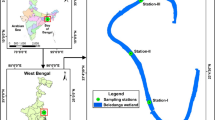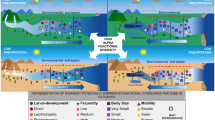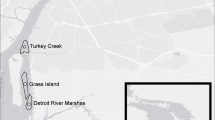Abstract
Hydrological alterations in Alpine rivers have been largely increasing due to the combined effects of global climate change and local impacts. Water flow intermittency starts with a process called lentification, which leads to the transformation of the aquatic ecosystem with severe consequences on biotic communities. These consequences have a greater impact in Alpine headwater streams, which are considered important and fragile hotspots of biodiversity and a source of threatened species; the new regime creates conditions to which native biota are poorly adapted. The main aim of our work was to evaluate taxonomical, functional and structural changes of diatom communities in Alpine rivers during the lentification process that precedes a supra-seasonal drought. Contrary to what was expected, communities exposed to river shrinking showed a level of homogeneity comparable to those collected in permanent sections. We therefore hypothesized that lentification created an intermediate disturbance that favoured heterogeneity of assemblages. Conversely, ecological guilds, growth forms and eco-morphological groups varied along temporal and spatial gradients driven by the lentification process. Small, motile and medium-sized low profile species were more abundant during summer, as well as adnate and stalked ones. Lentification limited the presence of high profile guilds and mucous-forming colonies. Droughts in Alpine streams are fairly recent processes, and the dynamics of aquatic communities facing water scarcity are largely unknown. The results we obtained provide important insights towards a more refined functional classification of diatoms for evaluating hydrological alterations.

Similar content being viewed by others
References
Adams GL, Pichler DE, Cox EJ, O’Gorman EJ, Seeney A, Woodward G, Reuman DC (2013) Diatoms can be an important exception to temperature—size rules at species and community levels of organization. Glob Chang Biol 19(11):3540–3552
Anderson MJ (2001) A new method for non-parametric multivariate analysis of variance. Austral Ecol 26(1):32–46
Anderson MJ, Ellingsen KE, McArdle BH (2006) Multivariate dispersion as a measure of beta diversity. Ecol Lett 9(6):683–693
APAT-IRSA CNR (2003) Metodi analitici per le acque, vol I. Rapporti 29/2003. APAT: Roma
Bard A, Renard B, Lang M, Giuntoli I, Korck J, Koboltschnig G, Janža M, d’Amico M, Volken D (2015) Trends in the hydrologic regime of Alpine rivers. J Hydrol 529:1823–1837
B-Béres V, Török P, Kókai Z, Krasznai ET, Tóthmérész B, Bácsi I (2014) Ecological diatom guilds are useful but not sensitive enough as indicators of extremely changing water regimes. Hydrobiol 738(1):191–204
B-Béres V, Lukács Á, Török P, Kókai Z, Novák Z, T-Krasznai E, Tóthmérész B, Bácsi I (2016) Combined eco-morphological functional groups are reliable indicators of colonisation processes of benthic diatom assemblages in a lowland stream. Ecol Indic 64(1):31–38
Boulton AJ, Lake PS (2008) Effects of drought on stream insects and its ecological consequences. Aquatic insects: challenges to populations. CABI Publishing, Wallingford, pp 81–102
Cáceres MD, Legendre P (2009) Associations between species and groups of sites: indices and statistical inference. Ecology 90(12):3566–3574
Calapez AR, Elias CL, Almeida SF, Feio MJ (2014) Extreme drought effects and recovery patterns in the benthic communities of temperate streams. Limnetica 33(2):281–296
Connell JH (1978) Diversity in tropical rainforest and coral reefs. Science 199:1302–1310
Denys L (1991) A check-list of the diatoms in the Holocene deposits of the western Belgian coastal plain with a survey of their apparent ecological requirements, vol I. In: Professional Paper. Geological Survey of Belgium, 1991/02 (246). Geologische Dienst van België: Brussels, p 41
Dudgeon D, Arthington AH, Gessner MO, Kawabata Z, Knowler DJ, Lévêque C, Naiman RJ, Prieur-Richard AH, Soto D, Stiassny MLJ, Sullivan CA (2006) Freshwater biodiversity: importance, threats, status and conservation challenges. Biol Rev 81:163–182
Dufrêne M, Legendre P (1997) Species assemblages and indicator species: the need for a flexible asymmetrical approach. Ecol Monogr 67(3):345–366
Elias CL, Calapez AR, Almeida SFP, Feio MJ (2015) From perennial to temporary streams: an extreme drought as a driving force of freshwater communities’ traits. Mar Freshwater Res 66:469–480
European Committee for Standardization (2003) Water Quality Guidance Standard for the Routine Sampling and Pretreatment of Benthic Diatoms from Rivers. European Standard EN 13946. Brussels, European Committee for Standardization, p 14
Falasco E, Bona F (2011) Diatom community biodiversity in an Alpine protected area: a study in the Maritime Alps Natural Park. J Limnol 70(2):157–167
Falasco E, Ector L, Ciaccio E, Hoffmann L, Bona F (2011) Alpine freshwater ecosystems in a protected area: a source of diatom diversity. Hydrobiologia 695:233–251
Falasco E, Piano E, Bona F (2016) Diatom flora in Mediterranean streams: flow intermittency threatens endangered species. Biodiversity Conserv 25:2965–2986
Fenoglio S, Bo T, Cucco M, Malacarne G (2007) Response of benthic invertebrate assemblages to varying drought conditions in the Po river (NW Italy). Ital J Zool 74(2):191–201
García L, Delgado C, Pardo I (2008) Seasonal changes of benthic communities in a temporary stream of Ibiza (Balearic Islands). Limnetica 27:259–272
Hope AB, Walker NA (1975) The physiology of giant algal cells, 166–167. University Press, Cambridge. Cited in: Raven JA, Geider RJ (1988) Temperature and algal growth. The New Phytologist 110: 441–461
Hudston MA (1979) A general hypothesis of species diversity. Am Nat 113:81–99
Ladrera R, Gomà J, Prat N (2018) Effects of Didymosphenia geminata massive growth on stream communities: smaller organisms and simplified food web structure. PLoS One 13(3):e0193545. https://doi.org/10.1371/journal.pone.0193545
Lake PS (2003) Ecological effects of perturbation by drought in flowing waters. Freshw Biol 48:1161–1172
Laliberté E, Legendre P, Shipley B (2014) FD: measuring functional diversity from multiple traits, and other tools for functional ecology. R package version 1.0–12
Lange-Bertalot H, Steindorf A (1996) Rote Liste der limnischen Kieselalgen (Bacillariophyceae) Deutschlands. Schriftenreihe Vegetationskunde 28:633–677
Ledger ME, Brown LE, Edwards F, Milner AM, Woodward G (2013) Droughts alter the structure and functioning of complex food webs. Nat Clim Change 3(3):223–227
Lepori F, Hjerdt N (2006) Disturbance and aquatic biodiversity: reconciling contrasting views. Bioscience 56:809–818
Oksanen J, Blanchet FG, Friendly M, Kindt R, Legendre P, McGlinn D, Minchin PR, O’Hara RB, Simpson GL, Solymos P, Stevens MHH, Szoecs E, Wagner H (2017) Vegan: Community Ecology Package. R package version 2.4–2
Piano E, Falasco E, Bona F (2017) Mediterranean rivers: consequences of water scarcity on benthic algal chlorophyll a content. J Limnol 76(s1):39–48
Pickett STA, White PS (1985) The ecology of natural disturbance and patch dynamics. Academic press, New York
Poff NL, Zimmerman JKH (2010) Ecological responses to altered flow regimes: a literature review to inform the science and management of environmental flows. Freshw Biol 55:194–205
R Core Team (2017) R: a language and environment for statistical computing. R version 3.4.2 "Short Summer", R Foundation for Statistical Computing, Vienna. https://www.R-project.org/. Accessed 28 Sept 2018
Ranzi R, Caronna P, Tomirotti M (2017) Impact of climatic and land use changes on river flows in the Southern Alps. In: Kolokytha E, Oishi S, Teegavarapu R (eds) Sustainable water resources planning and management under climate change. Springer, Singapore
Rimet F, Bouchez A (2012) Life-forms, cell-sizes and ecological guilds of diatoms in European rivers. Knowl Manag Aquat Ec 406:01–12
Ros MD, Marín-Murcia JP, Aboal M (2009) Biodiversity of diatom assemblages in a Mediterranean semiarid stream: implications for conservation. Mar Freshw Res 60:14–24
Sabater S (2008) Alterations of the global water cycle and their effects on river structure, function and services. Freshw Rev 1:75–88
Sabater S, Tockner K (2009) Effects of hydrologic alterations on the ecological quality of river ecosystems. In: Sabater S, Barceló D (eds) Water scarcity in the mediterranean. the handbook of environmental chemistry, vol 8. Springer, Berlin
Sabater S, Timoner X, Borrego C, Acuña V (2016) Stream biofilm responses to flow intermittency: from cells to ecosystems. Front Environ Sci 4:14
Sánchez-Castillo PM, Linares-Cuesta JE, Fernández-Moreno D (2008) Changes in epilithic diatom assemblages in a Mediterranean high mountain lake (Laguna de La Caldera, Sierra –Nevada, Spain) after a period of drought. J Limnol 67(1):49–55
Smith CR, McCormick PV, Covich AP, Golladay SW (2017) Comparison of macroinvertebrate assemblages across a gradient of flow permanence in an agricultural watershed. River Res Appl 33(9):1428–1438
Spaulding SA, Pool JR, Castro SI, Hinz F (2010) Species within the genus Encyonema Kützing, including two new species Encyonema reimeri sp. nov. and E. nicafei sp. nov. and E. stoermeri nom. nov., stat. nov. Proc Acad Nat Sci Phila 160:57–71
Stagl JC, Hattermann FF (2016) Impacts of climate change on riverine ecosystems: alterations of ecologically relevant flow dynamics in the Danube river and Its major tributaries. Water 8(12):566
Stubbington R, Wood PJ, Boulton AJ (2009) Low flow controls on benthic and hyporheic macroinvertebrate assemblages during supra-seasonal drought. Hydrol Process 23(15):2252–2263
Svensson F, Norberg J, Snoeijs P (2014) Diatom cell size, coloniality and motility: trade-offs between temperature, salinity and nutrient supply with climate change. PloS One 9(10):e109993
Tang T, Qian Niu S, Dudgeon D (2013) Responses of epibenthic algal assemblages to water abstraction in Hong Kong streams. Hydrobiologia 703:225–237
Acknowledgements
This work is part of the research fellowship “From perennial to intermittent: structural and functional responses of benthic diatom communities in Alpine and Appenninic rivers” funded by the Italian Ministry of Research (MIUR) in the framework of the Research Project of National Interest (PRIN) “NO ACQUA”, Grant No. 201572HW8F.
Author information
Authors and Affiliations
Corresponding author
Electronic supplementary material
Below is the link to the electronic supplementary material.
27_2018_587_MOESM1_ESM.xlsx
Electronic Supplementary Material 1. Complete checklist of diatom taxa detected in the three rivers during the experiment. The first two columns display the name and the OMNIDIA CODE of the taxa. The subsequent columns represent, respectively, the species growth form, the ecological guild to which the species belongs to, its mean biovolume and the eco-morphotype to which the species belongs. The last column shows the results of the Indicator Species Analysis on the following groups: SAMPLING MONTH (March, April, May, June, July, August); HABITAT (microhabitat -MH- or transect -T-); SITE LOCATION (upstream -UP- or downstream -DW- sections); FLOW VELOCITY (V=0 or V>0 m/s) (XLSX 44 KB)
27_2018_587_MOESM2_ESM.xlsx
Electronic Supplementary Material 2. Biological attributes of the diatom communities sampled in the three rivers, throughout the survey. Number of genera and species identified, Shannon diversity index and evenness (out of 400 individuals per sample). Percentage of relative abundance of eco-morphological guilds and growth forms detected in the three rivers throughout the survey. Mean values ± standard deviations are calculated on T and MH samples of both UP-DW sections (XLSX 19 KB)
Rights and permissions
About this article
Cite this article
Falasco, E., Piano, E., Doretto, A. et al. Lentification in Alpine rivers: patterns of diatom assemblages and functional traits. Aquat Sci 80, 36 (2018). https://doi.org/10.1007/s00027-018-0587-y
Received:
Accepted:
Published:
DOI: https://doi.org/10.1007/s00027-018-0587-y




